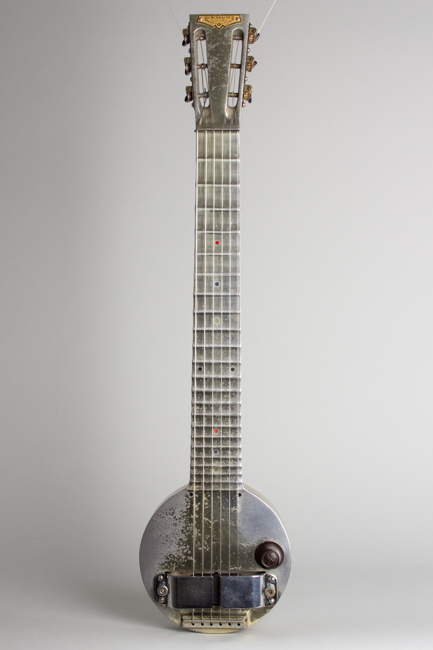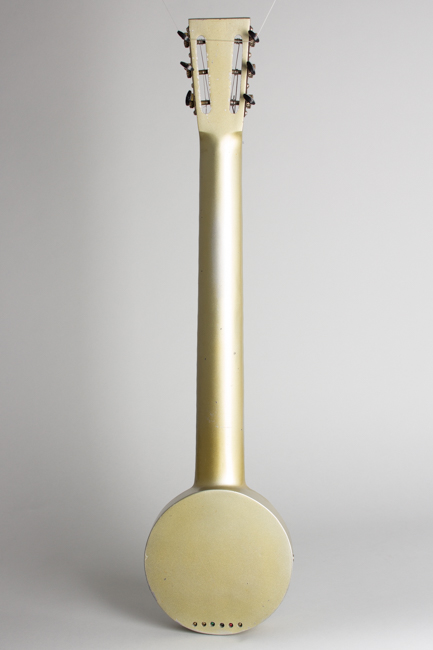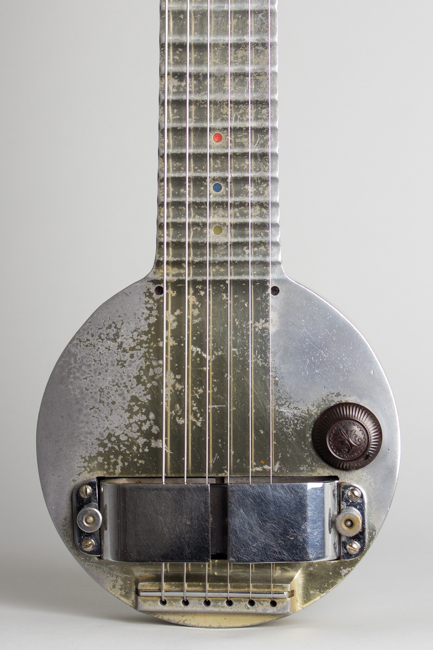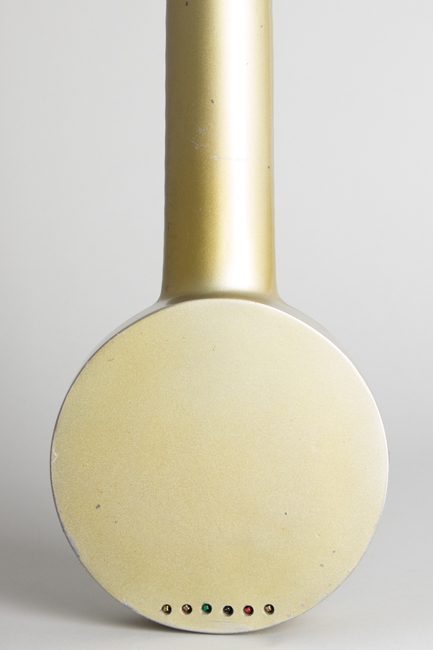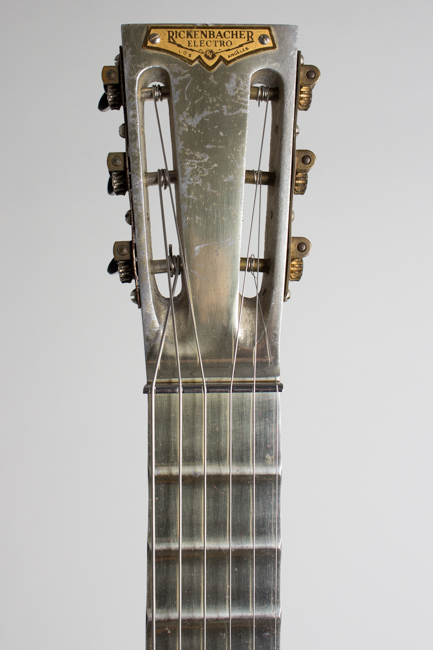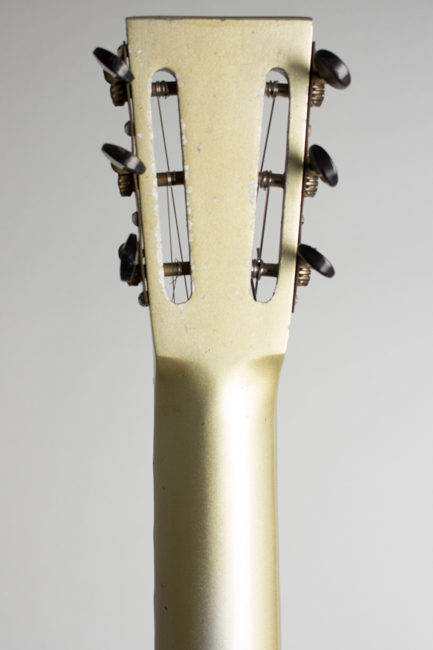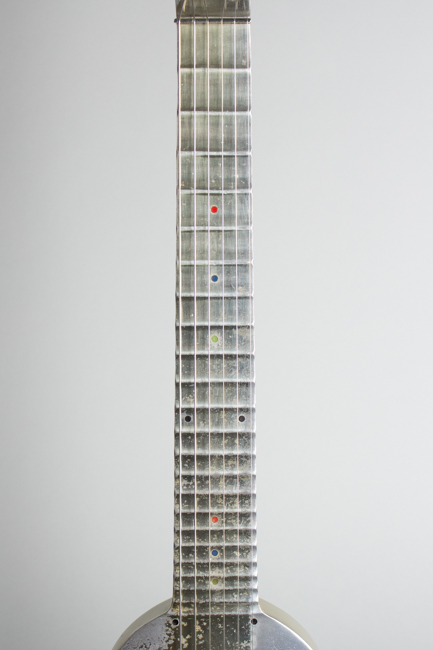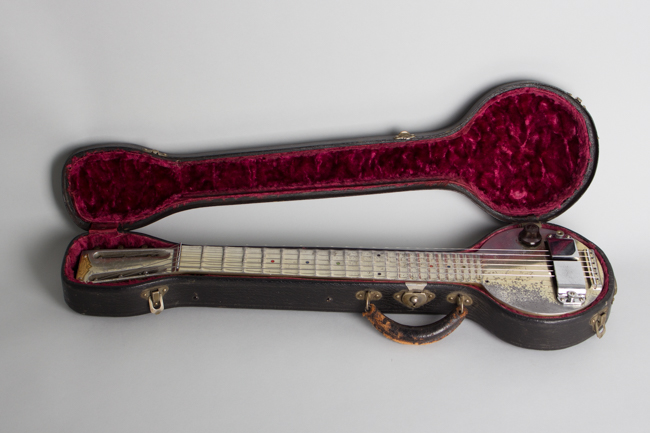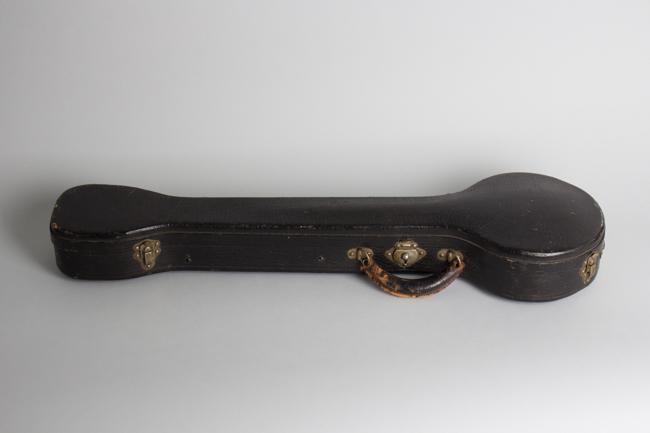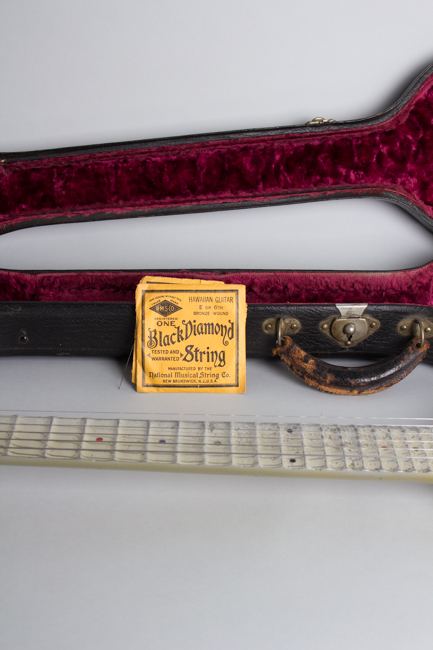Rickenbacker Model A-22 Lap Steel Electric Guitar (1935)
This item has been sold.
Item # 9611
Prices subject to change without notice.
Rickenbacker Model A-22 Model Lap Steel Electric Guitar (1935), made in Los Angeles, serial # B-279, gold enamel and natural aluminum finish, cast aluminum body, original black hard shell case.
The Rickenbacher A-22 Electro Hawaiian Guitar, nicknamed the "Frying Pan" for its distinctive shape is without a doubt one of the most historically important of all 20th century guitars. This was the first commercially successful electrified string instrument as well as the first solid body guitar. It was the initial carrier of the celebrated pre-war 1 1/2 inch horseshoe magnet pickup, the first electro-magnetic instrument pickup to be perfected and still one of the greatest-sounding units ever. While the Rickenbacker company went on to produce many other designs, the "Frying Pan" is where it all began for both this California company and electric guitars in general.
The very first few Rickenbacker Electros from 1932-3 had no onboard controls; these are exceptionally rare. This example is the second major variation with a single volume pot on the treble side of the top. The entire instrument extremely futuristic for the 1930's, a high deco minimalist design fabricated from a single piece of cast aluminum. The fingerboard is integral with the neck with raised ridges for frets and green, red, blue and black inlayed dot markers. Although the A-22 was marketed and almost always used as a Hawaiian guitar, the neck is round-backed and with a different set-up this instrument could have been played Spanish style - something designer George Beauchamp alludes to in the original patent application.
The strings run through the body and over a separate chromed metal saddle, through the horseshoe magnet pickup and on over a chromed brass nut to the slotted headstock. The slotted headstock carries a gold metal name plate reading "Richenbacher Electro, Los Angeles" with "RE" between mirrored lightning bolts. The serial number hand-stamped (rather sloppily) on the top edge of the headstock is B-279 marking this one as built after the 1935 introduction of the Bakelite Model B. While the "B" prefix is mostly found on the Bakelite guitars (the A-22 and long-scale companion A-25 were usually stamped with an "A" number) Rickenbacker's Los Angeles factory was pretty lackadaisical about sequences. Over the years we have seen a number of 1930's Rickenbacker instruments with the "wrong" prefix and some inexplicable numbering!
Overall length is 28 3/4 in. (73 cm.), 7 in. (17.8 cm.) width, and 1 5/8 in. (4.1 cm.) in depth, measured at side of rim. Scale length is 22 1/4 in. (565 mm.). Width of nut is 2 in. (51 mm.).
Overall this is a nicely preserved example of this rare and sought-after instrument. There is no serious damage or repair, just some general wear. The original gold lacquer wash finish on the back and sides shows some light wear but remains largely intact-on many survivors it is heavily chipped, flaked or even removed entirely. In this case there is some very light chipping but is about the most clean and intact of these finishes we have seen.
The top of the "pan" and fingerboard show heavier wear, mostly from play. The face of the body is worn down to the bare metal over the surfaces where players' hands made constant contact, while the fingerboard has dings and dents in the top surface from bar impacts. The top, fingerboard and headstock show some "foxing" spots where moisture has lifted small areas of the finish.
The instrument appears all original except for two components. The volume knob is a wonderfully elaborate Bakelite radio piece with a fleur-de-lys decorated top; it is larger and easier to manipulate than the original small octagonal knob. An original or original-style knob could early be re-installed but this appears to have been in place since the 1930's and is a part of the guitar's character. The tuner strips are of the period but not exactly matching; we suspect one or both sides were replaced long ago. The crucial pickup and wiring appear original and untouched.
The amazing and wonderful original shaped case with the leather handle and red plush lining is surprisingly well preserved. This the nicest of these seldom-seen cases we have encounteded. Many extant examples of this historic early electric guitar have been heavily worn or modified, usually with altered controls. According to legend at least many were melted down in the 1940's to reclaim valuable aluminum for the war production market. This is a very fine original "Frying Pan", played but not abused and with the pickup working perfectly. It still a delightful instrument to play and hear even aside from its historical value. Overall Excellent - Condition.
The Rickenbacher A-22 Electro Hawaiian Guitar, nicknamed the "Frying Pan" for its distinctive shape is without a doubt one of the most historically important of all 20th century guitars. This was the first commercially successful electrified string instrument as well as the first solid body guitar. It was the initial carrier of the celebrated pre-war 1 1/2 inch horseshoe magnet pickup, the first electro-magnetic instrument pickup to be perfected and still one of the greatest-sounding units ever. While the Rickenbacker company went on to produce many other designs, the "Frying Pan" is where it all began for both this California company and electric guitars in general.
The very first few Rickenbacker Electros from 1932-3 had no onboard controls; these are exceptionally rare. This example is the second major variation with a single volume pot on the treble side of the top. The entire instrument extremely futuristic for the 1930's, a high deco minimalist design fabricated from a single piece of cast aluminum. The fingerboard is integral with the neck with raised ridges for frets and green, red, blue and black inlayed dot markers. Although the A-22 was marketed and almost always used as a Hawaiian guitar, the neck is round-backed and with a different set-up this instrument could have been played Spanish style - something designer George Beauchamp alludes to in the original patent application.
The strings run through the body and over a separate chromed metal saddle, through the horseshoe magnet pickup and on over a chromed brass nut to the slotted headstock. The slotted headstock carries a gold metal name plate reading "Richenbacher Electro, Los Angeles" with "RE" between mirrored lightning bolts. The serial number hand-stamped (rather sloppily) on the top edge of the headstock is B-279 marking this one as built after the 1935 introduction of the Bakelite Model B. While the "B" prefix is mostly found on the Bakelite guitars (the A-22 and long-scale companion A-25 were usually stamped with an "A" number) Rickenbacker's Los Angeles factory was pretty lackadaisical about sequences. Over the years we have seen a number of 1930's Rickenbacker instruments with the "wrong" prefix and some inexplicable numbering!
Overall length is 28 3/4 in. (73 cm.), 7 in. (17.8 cm.) width, and 1 5/8 in. (4.1 cm.) in depth, measured at side of rim. Scale length is 22 1/4 in. (565 mm.). Width of nut is 2 in. (51 mm.).
Overall this is a nicely preserved example of this rare and sought-after instrument. There is no serious damage or repair, just some general wear. The original gold lacquer wash finish on the back and sides shows some light wear but remains largely intact-on many survivors it is heavily chipped, flaked or even removed entirely. In this case there is some very light chipping but is about the most clean and intact of these finishes we have seen.
The top of the "pan" and fingerboard show heavier wear, mostly from play. The face of the body is worn down to the bare metal over the surfaces where players' hands made constant contact, while the fingerboard has dings and dents in the top surface from bar impacts. The top, fingerboard and headstock show some "foxing" spots where moisture has lifted small areas of the finish.
The instrument appears all original except for two components. The volume knob is a wonderfully elaborate Bakelite radio piece with a fleur-de-lys decorated top; it is larger and easier to manipulate than the original small octagonal knob. An original or original-style knob could early be re-installed but this appears to have been in place since the 1930's and is a part of the guitar's character. The tuner strips are of the period but not exactly matching; we suspect one or both sides were replaced long ago. The crucial pickup and wiring appear original and untouched.
The amazing and wonderful original shaped case with the leather handle and red plush lining is surprisingly well preserved. This the nicest of these seldom-seen cases we have encounteded. Many extant examples of this historic early electric guitar have been heavily worn or modified, usually with altered controls. According to legend at least many were melted down in the 1940's to reclaim valuable aluminum for the war production market. This is a very fine original "Frying Pan", played but not abused and with the pickup working perfectly. It still a delightful instrument to play and hear even aside from its historical value. Overall Excellent - Condition.
